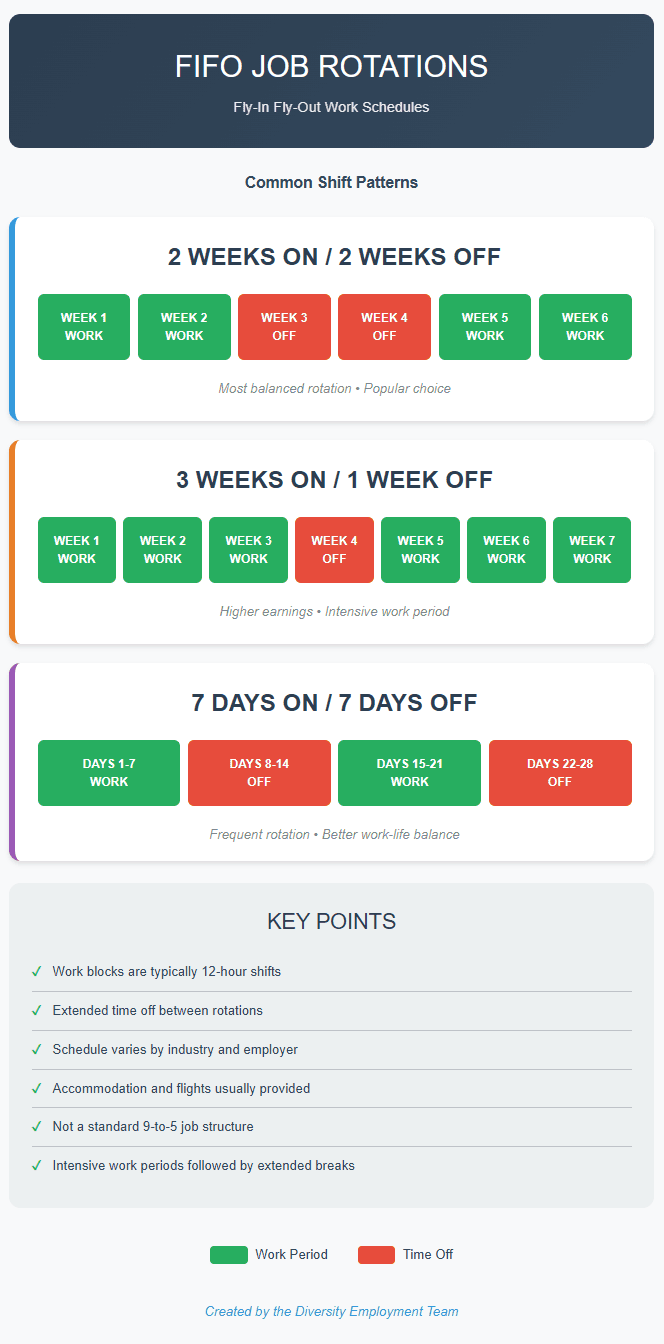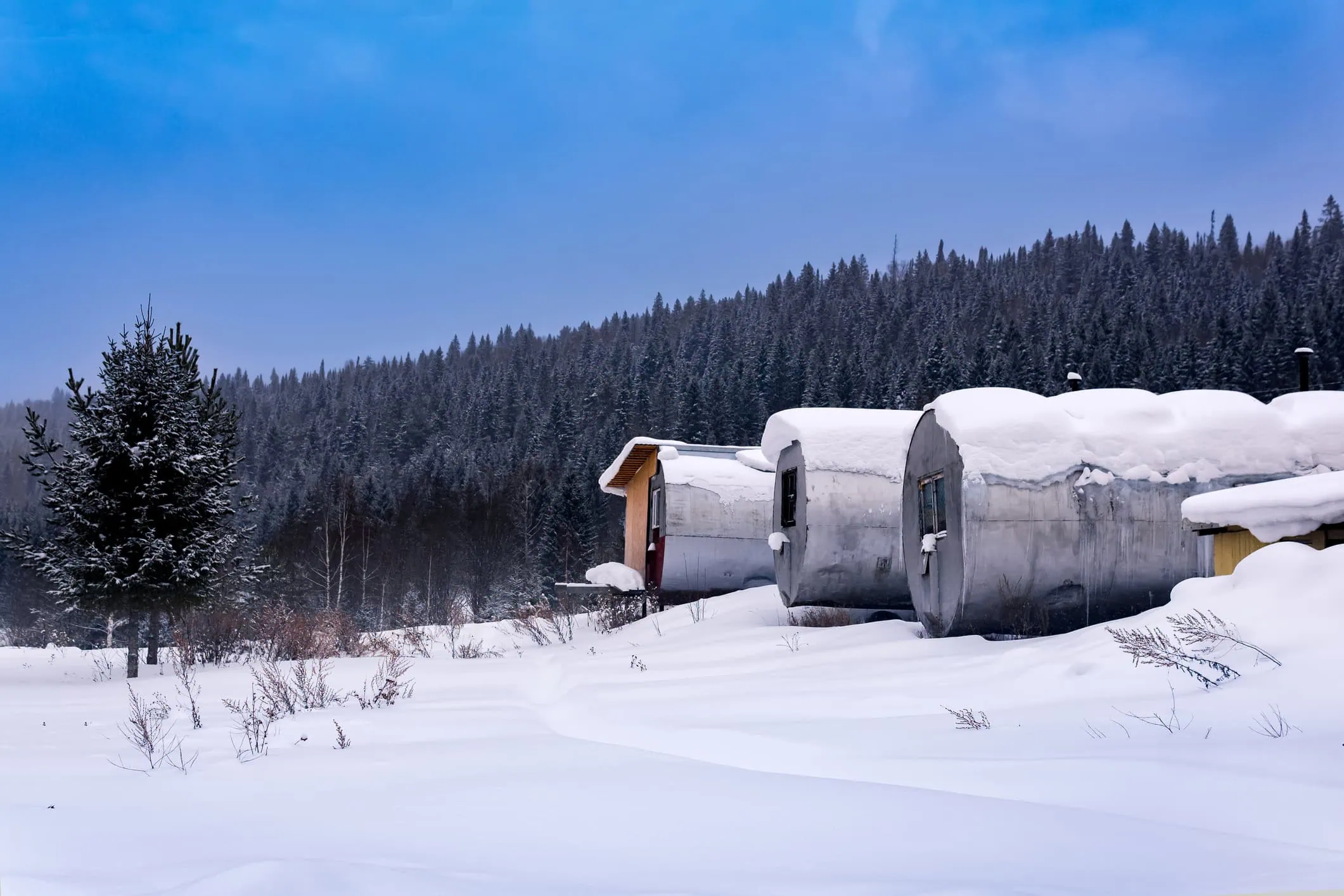What Are FIFO Jobs?
FIFO jobs are fly-in fly-out jobs and are pretty much exactly what they sound like. They require employees to travel to remote work locations, stay for a designated period, and then return home during scheduled time off. These positions are especially common in industries where operations are based far from population centers, and building a full-time local workforce isn’t practical .
FIFO jobs are definitely more widely known in Australia or Canada, these jobs do exist in the U.S. Particularly in remote areas such as Alaska, rural oil fields, and isolated mining regions. Workers are typically flown in for multi-day or multi-week shifts, normally working long hours, then fly back home for extended rest periods.
These jobs come with some unique advantages and challenges. For some people, it’s a chance to earn really good pay, gain industry experience, and take advantage of travel benefits. For the rest of us, that type of remote lifestyle and extended time away from home may be a tough tradeoff.
If you’re considering a FIFO job or are just curious about what they are, read on to find where these jobs are found, who they’re best suited for, and what it takes to land one.
Who FIFO Roles Are For
FIFO jobs aren’t average 9-to-5’s, they’re ideal for people who are adaptable, self-reliant, and comfortable spending extended time away from home. They demand long shifts, unusual schedules, and remote living… but they also come with serious perks for the right person.
FIFO jobs are a good fit if you:
- Enjoy physical or hands-on work: Many FIFO roles are in mining, construction, or maintenance. Those fields normally keep you on your feet and working with your hands.
- Prefer an untraditional schedule: FIFO often involves rotations like two weeks on, one week off, giving you less time off at home.
- Are early in your career and want to build experience fast: The fast-paced, demanding nature of FIFO work can help you rack up valuable experience (and savings) quickly.
- Are looking for high pay with fewer distractions: With meals, housing, and travel often covered, FIFO can be a great way to save money, especially for those without family obligations.
- Don’t mind being off the grid: Many FIFO job sites are in remote or isolated areas with limited connectivity. You’ll need to be okay with fewer creature comforts.
Less ideal for:
- Parents with young children or caregivers who need to be home regularly
- Anyone who struggles with isolation or tight quarters
- People who need consistent access to city amenities or fast internet
FIFO work isn’t glamorous, but for the right person, it can be a smart, high-reward option that supports financial goals, career growth, and a unique lifestyle.
Common FIFO Jobs & Industries
FIFO jobs aren’t limited to just one type of work. While most people think of mining or oil rigs, the reality is there’s way more than that. You can find these jobs wherever the job site is too remote for daily commuting. The work still needs doing around the clock.
Here are the most common industries where FIFO jobs are:
Mining
In places like Alaska and other parts of the Western U.S., FIFO work is essential to mineral gathering and resource extraction operations.
Typical roles include:
- Heavy equipment operators like excavators, loaders, haul trucks
- Drill and blast technicians
- Mechanics and maintenance technicians
- Ore processing plant workers
- Site geologists or safety officers
These jobs call for a high level of physical stamina and following strict safety protocols. Experience in harsh weather or rugged terrain is often a bonus.
Oil & Gas
Offshore rigs, shale plays, and pipeline construction projects often use FIFO schedules due to extreme isolation or lack of local housing.
Common FIFO oil & gas roles:
- Roustabouts and rig hands
- Welders, pipefitters, and electricians
- Workover rig floorhands and drillers
- Safety inspectors and crane operators
- Environmental compliance techs
These roles often offer high compensation but come with extended time on-site and unpredictable conditions.
Construction
Large-scale government and infrastructure projects from dams to remote highways to energy plants usually rely on FIFO labor.
Some FIFO construction roles:
- Equipment operators (bulldozers, cranes, graders)
- General laborers and site foremen
- Carpenters, electricians, and HVAC techs
- Concrete and road paving specialists
- Surveyors and project engineers
Union membership or certification in a specific trade is often required. These jobs are great for workers looking to rack up hours and earn hazard or remote location pay.
Food Service & Camp Support
FIFO sites operate like mini-cities. Workers still need to eat, sleep, and function off-shift — and that means entire hospitality teams are flown in, too.
FIFO camp roles include:
- Camp cooks and kitchen assistants
- Housekeepers and janitorial staff
- Security personnel
- Administrative and logistics coordinators
- Medical support (EMTs, nurses, first-aid attendants)
These jobs may not require technical experience, but they demand flexibility, reliability, and comfort with communal living situations.
Logistics & Remote Operations
Some FIFO opportunities exist outside the “heavy industries.” If the location is hard to reach and the job needs staffing, FIFO may apply.
Roles often include:
- Warehouse staff and inventory control
- Remote IT support and field technicians
- Helicopter or bush plane pilots
- Wildlife researchers or fire suppression crews
- Telecom and satellite service crews
These jobs may fly under the radar, but they’re vital to keeping remote sites connected, supplied, and functioning.
No matter which industry you’re looking into, FIFO jobs share one thing, that they’re built for people who can handle intensity, isolation, and the rewards that come with both. you’re operating a crane, preparing meals, or maintaining tech in the middle of nowhere, FIFO work calls for commitment, grit, and the ability to thrive off the beaten path.
Typical Schedules and Compensation
FIFO jobs aren’t at all standard 9-to-5 jobs. These roles follow a rotation schedule meaning you work intensively for a block of time (like two to four weeks straight), then take an extended period off. The usual rotations are: 2 weeks on/2 weeks off, 3 weeks on/1 week off, or 7 days on/7 days off. The actual times change depending on the industry or employer.
During the “on-shift” period, shifts are normally 10 to 14-hours, seven days a week. Any given shift can turn into a series of team building activities, especially when the work is as intense and dangerous as it can be. Also, because you’re already on-site and there’s nowhere else to be or any one else to be with, employers expect a high level of teamwork, commitment and availability. In return, the time off is truly off… no checking email, no “availability just in case.” You’re flown home and given full time to rest time before your next stint.

What’s Included in FIFO Pay?
Due to the extremely demanding nature and remote locations, FIFO roles offer higher-than-average pay for the same jobs in cities or urban areas. Additional compensation usually includes:
- Above-market hourly wages or flat day rates to account for long shifts and tough conditions.
- Overtime pay for anything beyond the standard shift structure.
- Free or subsidized flights to and from the job site.
- Room and board included, typically in a “man camp” or dedicated employee housing.
- Per diem or daily living allowance for incidentals.
Union vs. Non-Union Sites
In some FIFO jobs, especially large-scale construction or mining projects, union membership can be required. Union sites often provide:
- Set pay scales and clear overtime rules.
- Stronger safety enforcement and better job protection.
- Pre-negotiated benefits such as health coverage, or matched retirement contributions.
Non-union sites might come with more flexibility but they typically come with less protection too, so it’s important to understand the tradeoffs before signing a contract.
Where FIFO Jobs Are Found in the U.S.
FIFO jobs aren’t as popular in the U.S. as they are in places like Canada and Australia, but they are still critical to remote and resource-heavy regions. You can mostly find these jobs where infrastructure is limited, local labor is scarce, and the cost of relocating full-time workers is too high. Most positions are linked to large scale extraction, construction, or logistics projects where companies need these diverse staffing jobs filled by skilled laborers without building permanent housing or communities.
Alaska
Remote energy sites, mining operations, and wilderness infrastructure make Alaska the top U.S. state for FIFO employment. Seasonal peaks (especially in summer) bring heavy demand for drill operators, mechanics, camp support staff, cooks, and environmental techs.
- Common locations: North Slope oil fields, Yukon River mining sites, Arctic Circle exploration camps.
North Dakota
The Bakken Shale oil boom created a surge in FIFO employment, and while the demand has fluctuated, drilling, pipeline work, and logistical support roles are still flown in for weeks at a time.
- FIFO hotspots: Williston, Watford City, and surrounding oil-producing areas.
West Texas
The Permian Basin is one of the most active oil-producing areas in the U.S., but permanent housing hasn’t kept up with labor demand. FIFO workers are brought in for everything from pipeline inspection to food service at drill sites.
- Expect rotation work in drilling, safety monitoring, and equipment repair.
Nevada, Utah, and Montana
These Western states are home to hard rock mining and precious metal extraction sites. Many are deep in national forest or mountainous terrain, which makes FIFO the go-to staffing solution.
- Mines in Elko (NV), Butte (MT), and central Utah frequently fly in engineers, machine operators, and diesel techs.
Tribal Lands and National Infrastructure Zones
Some government or federally funded construction projects are located in extremely isolated areas, on tribal land, protected wilderness, or desert regions, where local workforces are small and FIFO staffing helps close the gap.
- These jobs may include dam construction, broadband infrastructure, or rural energy expansion, especially in the Midwest and Southwest.
Benefits of FIFO Jobs
FIFO jobs offer some serious upsides for those willing to put in the work. They usually come with unique perks that make them especially attractive to skilled workers looking to gain more income or get rare field experience.
High Earning Potential in Short Time Frames
Because FIFO jobs require extended time on-site and significant personal flexibility, they often pay well above average, sometimes with hazard pay, overtime, or daily bonuses. The condensed rotation cycles (like 2 weeks on, 2 weeks off) mean you can earn what some people make in a full month… in half the time.
Paid Travel, Housing, and Meals
One of the biggest benefits? Your essentials are usually covered. Flights to and from the site, on-site lodging, and all meals are included. For workers without permanent housing needs, or those who want to save aggressively, this setup can lead to major cost-cutting and financial gain.
Ideal for Saving or Paying Off Debt
No rent. Groceries. No commuting. Combine all that with a big ‘ol paycheck, and FIFO work starts looking like a great opportunity to build savings, pay off loans, or save up for a career switch. It’s a strategic move for anyone focused on short-term financial goals.
Access to Specialized Experience
FIFO roles drop you into high-impact environments. From places like a gold mine in Alaska to a pipeline in West Texas, you’ll gain hands-on experience with tools, teams, and terrain that you can’t find in typical city jobs. That can be a huge asset if you’re building a resume in construction, trades, logistics, or even engineering.
Natural Work-Life Separation
With FIFO jobs, you’re either working or you’re off. When you’re on rotation, it’s go time. But when you’re off? You’re fully disconnected. That break can offer a true reset, with no emails, no partial workweeks, and no “bleed” between professional and personal life.
The Real Challenges of FIFO Work
For the right person, FIFO jobs pay very well and they’re a great way to stack cash and gain hands-on experience. But let’s not sugarcoat it… this kind of work comes with tradeoffs that can wear you down if you’re not prepared.
You’ll Miss Things at Home
This one hits hardest for most people. Missing birthdays, milestones, and daily life with the people you care about is common when you’re gone for weeks at a time. And if you’ve got a family, especially with young kids, the strain can build up pretty fast. Even when you’re single, extended stretches away from home can take a toll on your relationships, family, and friendships.
It’s Hard on the Body & the Mind
Long shifts, intense physical labor, extreme harsh weather, and strict safety rules should be expected. Climbing ladders, working through loud noise, cold or heat, or needing to stay hyper-focused for 12+ hours at a time can wear anyone down. When rest is limited and recovery time is short it makes FIFO jobs that much more challenging. And mentally, it can be tough to stay 100% and positive when you’re far from home and running on low energy.
Camp Life Isn’t for Everyone
To be honest, remote work sites aren’t exactly glamorous. FIFO jobs normally have employees sleep in shared quarters, eat in a communal dining hall, and see the same faces day in and day out. Some people find comfort in this kind of routine, while others can feel boxed in. There’s not much privacy, and personal space becomes limited, to say the least.
Climbing the Ladder Can Be Tricky
Most FIFO jobs are temporary or tied to specific projects. You’re usually there to do one thing, and once it’s done, you move on. If you’re hoping for a quick promotion or steady career growth, the path isn’t always the easiest. You might need to jump from job to job, and keep updating your resume with new experiences and skills, to keep moving up.
Life Outside Work Takes a Hit
FIFO jobs can throw off everything from fitness goals, personal projects, classes, to even weekend plans. Between the travel time, long shifts, and the much needed recovery days, it is difficult to keep up with a routine or even make time for much else. That uncertainty can mess with anyone’s rhythm, especially if you value consistency.
How to Land a FIFO Job

Getting a FIFO job starts by proving you’re dependable, skilled, and ready to handle the lifestyle, not just being willing to work in a remote location. Here’s how to set yourself apart from the pack and get on a crew.
-
Get Credentials
Most FIFO employers won’t even consider a resume lacking certain job-specific certifications or relevant safety training. Depending on the industry, you may need:
- OSHA 10-hour to 30-hour training: This basic and general safety training covers a wide range of topics and goes deeper with the longer the training sessions.
- TWIC card: A Transportation Worker Identification Credential is a biometric id card for maritime or port-based jobs.
- MSHA certification: Mine Safety and Health Administration certification for working in the mines.
- H2S Awareness: Hydrogen Sulfide awareness training is for anyone working near toxic gas, especially when working with oil and gas.
Plus, some jobs call for more niche credentials, a Confined Space Certificate, First Aid/CPR, Commercial Drivers Licenses, Trade Certifications, or Union Membership.
-
Build a Clean, Industry-Specific Resume
Your resume should highlight the following:
- Relevant field experience.
- Certifications that apply to the job.
- Any remote or rotational work you’ve done.
Show that you’re reliable, adaptable, and safety-minded. For FIFO jobs, fluff won’t cut it. Employers need to know you can show up, suit up, and get the job done. You’re a big investment once hired.
-
Know the Lifestyle
Employers are looking for candidates who really understand what FIFO jobs are. In interviews:
- Be honest about your availability.
- Detail your experience with long shifts or remote sites.
- Highlight your attitude toward rotation-based work.
If you’ve done any shift work before, even in a different industry, make sure you mention it.
-
Research Employers and Contracts Carefully
FIFO jobs can be majorly different from one another. Look into:
- Rotation length and schedule
- Living conditions; are they shared or private quarters? What are the amenities?
- Travel arrangements and who pays for them
- Contract duration and benefits
It’s a smart idea to read company reviews, talk to current and/or former employees, if you can, and make sure the job terms are clearly outlined before you sign anything.
-
Use the Right Channels
Instead of relying only on general or even diversity job boards, keep a look out for industry-specific recruiters, union job postings, or training programs that might connect graduates with future FIFO jobs. Trade schools, workforce development programs, and professional networks are usually better ways to get your foot in the door.
Is FIFO Work Right for You?
Fly-In Fly-Out jobs definitely aren’t for everyone… and that’s okay. But for the right workers, they have some serious advantages: better pay, a chance to work on major projects, and the ability to stack savings fast. You’ll most likely gain skills and experience that you would never be able to get in a traditional setting. And for many, that alone makes the trade-offs worthwhile.
Still, it’s important to walk in with clear eyes. FIFO jobs demand a lot of time, energy, flexibility, and overall resilience. You have to be okay with long stretches away from home, rotating schedules, and a lifestyle that doesn’t always leave room for many outside commitments.
If you’ve got the training, the mindset, and a sense of adventure, FIFO work could be your fast track to a better financial future or even a long-term career path in industries that are always hiring. Just know what you’re signing up for, and go in ready to work hard and adapt.




